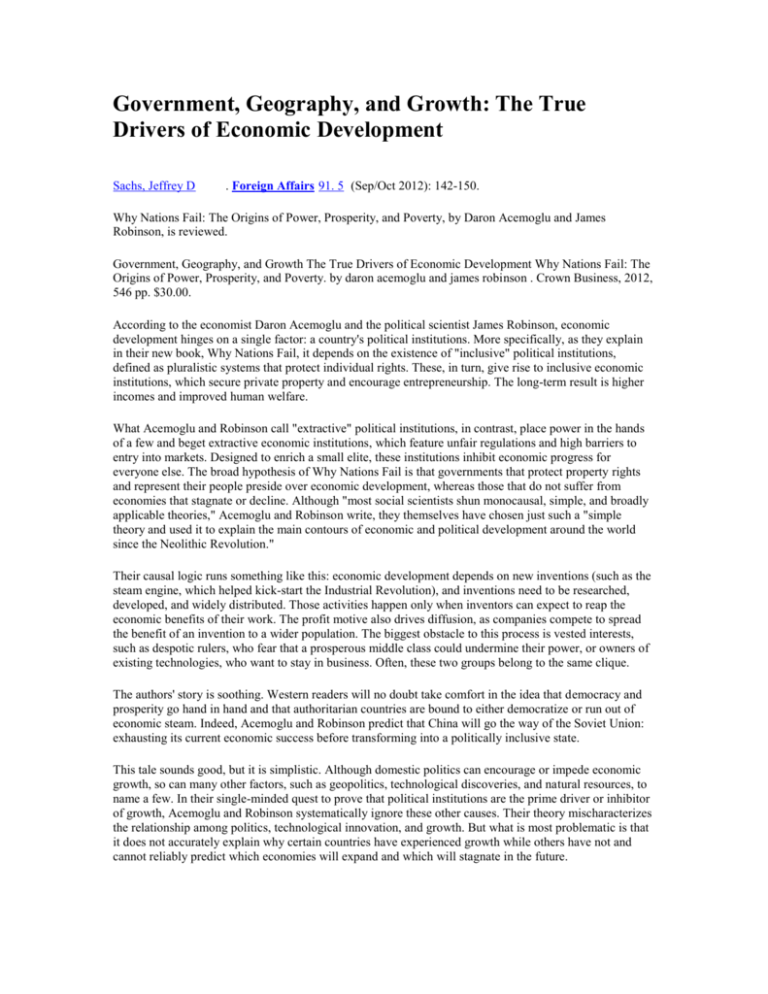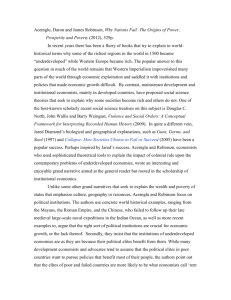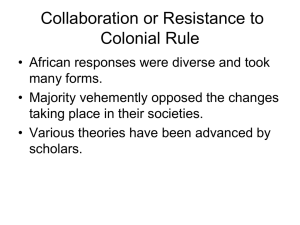Government, Geography and Growth: The True Drivers of
advertisement

Government, Geography, and Growth: The True Drivers of Economic Development Sachs, Jeffrey D . Foreign Affairs 91. 5 (Sep/Oct 2012): 142-150. Why Nations Fail: The Origins of Power, Prosperity, and Poverty, by Daron Acemoglu and James Robinson, is reviewed. Government, Geography, and Growth The True Drivers of Economic Development Why Nations Fail: The Origins of Power, Prosperity, and Poverty. by daron acemoglu and james robinson . Crown Business, 2012, 546 pp. $30.00. According to the economist Daron Acemoglu and the political scientist James Robinson, economic development hinges on a single factor: a country's political institutions. More specifically, as they explain in their new book, Why Nations Fail, it depends on the existence of "inclusive" political institutions, defined as pluralistic systems that protect individual rights. These, in turn, give rise to inclusive economic institutions, which secure private property and encourage entrepreneurship. The long-term result is higher incomes and improved human welfare. What Acemoglu and Robinson call "extractive" political institutions, in contrast, place power in the hands of a few and beget extractive economic institutions, which feature unfair regulations and high barriers to entry into markets. Designed to enrich a small elite, these institutions inhibit economic progress for everyone else. The broad hypothesis of Why Nations Fail is that governments that protect property rights and represent their people preside over economic development, whereas those that do not suffer from economies that stagnate or decline. Although "most social scientists shun monocausal, simple, and broadly applicable theories," Acemoglu and Robinson write, they themselves have chosen just such a "simple theory and used it to explain the main contours of economic and political development around the world since the Neolithic Revolution." Their causal logic runs something like this: economic development depends on new inventions (such as the steam engine, which helped kick-start the Industrial Revolution), and inventions need to be researched, developed, and widely distributed. Those activities happen only when inventors can expect to reap the economic benefits of their work. The profit motive also drives diffusion, as companies compete to spread the benefit of an invention to a wider population. The biggest obstacle to this process is vested interests, such as despotic rulers, who fear that a prosperous middle class could undermine their power, or owners of existing technologies, who want to stay in business. Often, these two groups belong to the same clique. The authors' story is soothing. Western readers will no doubt take comfort in the idea that democracy and prosperity go hand in hand and that authoritarian countries are bound to either democratize or run out of economic steam. Indeed, Acemoglu and Robinson predict that China will go the way of the Soviet Union: exhausting its current economic success before transforming into a politically inclusive state. This tale sounds good, but it is simplistic. Although domestic politics can encourage or impede economic growth, so can many other factors, such as geopolitics, technological discoveries, and natural resources, to name a few. In their single-minded quest to prove that political institutions are the prime driver or inhibitor of growth, Acemoglu and Robinson systematically ignore these other causes. Their theory mischaracterizes the relationship among politics, technological innovation, and growth. But what is most problematic is that it does not accurately explain why certain countries have experienced growth while others have not and cannot reliably predict which economies will expand and which will stagnate in the future. DIAGNOSING DEVELOPMENT Acemoglu and Robinson's simple narrative contains a number of conceptual shortcomings. For one, the authors incorrectly assume that authoritarian elites are necessarily hostile to economic progress. In fact, dictators have sometimes acted as agents of deep economic reforms, often because international threats forced their hands. After Napoleon defeated Prussia in 1806 at the Battle of Jena, Prussia's authoritarian rulers embarked on administrative and economic reforms in an effort to strengthen the state. The same impulse drove reforms by the leaders behind Japan's Meiji Restoration in the late nineteenth century, South Korea's industrialization in the 1960s, and China's industrialization in the 1980s. In each case, foreign dangers and the quest for national opulence overshadowed the leaders' concerns about economic liberalization. In their discussion of the incentives facing elites, Acemoglu and Robinson ignore the fact that those elites' political survival often depends as much on external as internal circumstances, leading many struggling states to adopt the institutions and technologies of the leading states in a quest to c lose economic gaps that endanger the state and society. The authors also conflate the incentives for technological innovation and those for technological diffusion. The distinction matters because the diffusion of inventions contributes more to the economic progress of laggard states than does the act of invention itself. And authoritarian rulers often successfully promote the inflow of superior foreign technologies. A society without civil, political, and property rights may indeed find it difficult to encourage innovation outside the military sector, but it often has a relatively easy time adopting technologies that have already been developed elsewhere. Think of cell phones. Invented in the United States, they have rapidly spread around the world, to democracies and nondemocracies alike. They have even penetrated Somalia, a country that has no national government or law to speak of but does have a highly competitive cell-phone sector. In fact, most of the economic leaps that laggard countries have made can probably be credited not to domestic technological innovations but to flows of technology from abroad, which in turn have often been financed by export receipts from natural resources and low wage industries. China did not become the fastest-growing large economy in history after 1980 thanks to domestic invention; it did so because it rapidly adopted technologies that were created elsewhere. And unlike the Soviet Union, China has not sought in vain to develop its own technological systems in competition with the West. It has instead aimed, with great skill, to integrate its local production into global technological systems, mastering the technologies in the process. China will likely become an important innovator in the future, but innovation has not been the key to the country's 30 years of torrid growth. What's more, authoritarian political institutions, such as China's, can sometimes speed, rather than impede, technological inflows. China has proved itself highly effective at building large and complex infrastructure (such as ports, railways, fiber-optic cables, and highways) that complements industrial capital, and this infrastructure has attracted foreign private-sector capital and technology. And just like inclusive governments, authoritarian regimes often innovate in the military sector, with benefits then spilling over into the civilian economy. In South Korea and Taiwan, for example, public investments in military technology have helped seed civilian technologies. The book misinterprets the causes of growth in another way. Acemoglu and Robinson correctly identify state power- "political centralization," in their words- as a necessary precursor to economic development. After all, only a strong government can keep the peace, build infrastructure, enforce contracts, and provide other public goods. But in Acemoglu and Robinson's version of events, a state's strength arises from the choices made by its ruling elites. The authors forget that a state's power depends not just on the willpower of these elites but also on an adequate resource base to help finance that capacity. In their discussion of Africa, for example, Acemoglu and Robinson recognize that the continent's lack of centralized states and long history of colonial rule have set its development far back, but they never adequately explain why sub-Saharan African governments were localized and weak to begin with. Geography has a lot to do with it. Sub- Saharan Africa's geographic conditions- its low population densities before the twentieth century, high prevalence of disease, lack of navigable rivers for transportation, meager productivity of rainfed agriculture, and shortage of coal, among others-long impeded the formation of centralized states, urbanization, and economic growth. Adam Smith recognized Africa's transportation obstacles back in 1776 in The Wealth of Nations. These transport problems, along with ecological and resource-related weaknesses, made Africa vulnerable to invasion and conquest by Europe in the late nineteenth century (after the Europeans learned to protect themselves against malaria with quinine), and they still hamper development in some parts of the continent today. Not only can unfavorable geography cripple states; it can also slow the development and diffusion of technology. Again, however, Acemoglu and Robinson leave this variable out of their equation for economic growth, failing to acknowledge that diffusion requires not only inclusive political institutions but also sufficiently low costs of adopting the new technologies. In places where production is expensive because of an inhospitable climate, unfavorable topography, low population densities, or a lack of proximity to global markets, many technologies from abroad will not arrive quickly through foreign investments or outsourcing. Compare Bolivia and Vietnam in the 1990s, both places I experienced firsthand as an economic adviser. Bolivians enjoyed greater political and civil rights than the Vietnamese did, as measured by Freedom House, yet Bolivia's economy grew slowly whereas Vietnam's attracted foreign investment like a magnet. It is easy to see why: Bolivia is a landlocked mountainous country with much of its territory lying higher than 10,000 feet above sea level, whereas Vietnam has a vast coastline with deep-water por ts conveniently located near Asia's booming industrial economies. Vietnam, not Bolivia, was the desirable place to assemble television sets and consumer appliances for Japanese and South Korean companies. The overarching effect of these analytic shortcomings is that when Acemoglu and Robinson purport to explain why nations fail to grow, they act like doctors trying to confront many different illnesses with only one diagnosis. In any system with many interacting components, whether a sick body or an underperforming economy, failure can arise for any number of reasons. The key to troubleshooting complex systems is to perform what physicians call a "differential diagnosis": a determination of what has led to the system failure in a particular place and time. Bad governance is indeed devastating, but so, too, are geopolitical threats, adverse geography, debt crises, and cultural barriers. Poverty itself can create selfreinforcing traps by making saving and investment impossible. THE POWER OF THE MAP To make a convincing case that political institutions alone determine economic development, one would have to conduct an exceptionally rigorous analysis to overcome the huge amount of data strongly suggesting that other factors also play an important role in development; as the astrophysicist Carl Sagan said, "Extraordinary claims require extraordinary evidence." Yet Acemoglu and Robinson do nothing of the sort. They never define their key variables with precision, present any quantitative data or classifications based on those definitions, or offer even a single table, figure, or regression line to demonstrate the relationships that they contend underpin all economic history. Instead, they present a stream of assertions and anecdotes about the inclusive or extractive nature of this or that institution. And even their own narratives betray a chronic blindness to competing explanations. Consider South Korea's development. As Acemoglu and Robinson recognize, President Park Chung-hee, who was in power from 1961 to 1979, ran an extractive political system that still somehow managed to create inclusive economic institutions. Contrary to what the Acemoglu-Robinson hypothesis would predictthat political reform precedes economic growth-Park and his allies, although they represented an authoritarian elite, were motivated by a desire to strengthen the state and develop the economy so that South Korea could survive on a divided peninsula and in a highly competitive region. Moreover, the country's economic progress from 1970 until around 2000 had less to do with the authors' preferred explanation of homegrown innovation than with its remarkable success at reverse engineering and at manufacturing equipment for established firms located overseas. Eventually, South Korea's economic success promoted political democratization and homegrown innovation. Authoritarian- led economic progress came first. South Korea's style of growth is far more typical than Acemoglu and Robinson acknowledge. Indeed, the pattern is so familiar that it has been given a name: "the East Asian developmental state model," or, more generally, "state capitalism." China, Singapore, Taiwan, and Vietnam all began with extractive political institutions and ended up with more inclusive economic institutions. In every case, economic development either preceded political reform or has so far not led to it. Whereas South Korea and Taiwan became democracies after the economic reforms of their authoritarian rulers, China and Vietnam have not yet democratized, and Singapore is semidemocratic. These outcomes contradict Acemoglu and Robinson's theory that inclusive political institutions pave the way for growth and that without such institutions, economies will inevitably sputter out. The South Korean and Taiwanese examples serve as a reminder of an easy mistake to make when using Acemoglu and Robinson's framework. Inclusive political institutions in South Korea and Taiwan today are associated with inclusive economic institutions. Yet historically, the causation in both countries ran from economic reforms to political democratization, not the other way around. The fact that inclusive political and economic institutions are correlated in today's world does not mean that the for mer caused the latter. There are also countries that possess both inclusive political and inclusive economic institutions yet never achieve much development, often due to geographic barriers. That seemed to be the fate awaiting Botswana in 1966, when it gained independence. Back then, the country was one of the poorest places on the planetno surprise for a landlocked desert. But over the following decades, the country emerged as an economic success story, and it now boasts one of the highest per capita incomes in Africa. So what changed? According to Acemoglu and Robinson, Botswana broke the mold "by quickly developing inclusive economic and political institutions after independence." The authors wax rhapsodic about the Tswana people's long tradition of political inclusion, which meant that at independence, they "emerged with a history of institutions enshrining limited chieftaincy and some degree of accountability of chiefs to the people." Oh, and yes, did they mention the diamonds? In 1967, prospectors discovered a gargantuan deposit of diamonds that would become the world's largest diamond mine, and other discoveries soon followed. During the 1970s and 1980s, the diamond boom remade the economy of this tiny desert state, which became one of the world's largest producers and exporters of diamonds. Botswana's diamond revenues, which soared to over $1,000 per citizen, have provided more than half of all its export earnings and a substantial proportion of its budget receipts. Yet in Acemoglu and Robinson's telling, diamonds are just a sideshow. Perhaps the authors would retort that Botswana has outperformed other diamond producers, such as Sierra Leone, and that its inclusive institutions account for the difference. Even so, critical geographic forces are still at work. Botswana is blessed with far greater reserves than Sierra Leone, earning diamond revenues of around $1,500 per person annually, compared with under $30 for Sierra Leone. Moreover, Botswana's diamond mines have been managed by a large corporation (De Beers) closely aligned with South Africa, Botswana's powerful neighbor, making it harder, perhaps, for Botswana's elites to run away with all the wealth. Such institutional details, which are at least as important as the political history of the Tswana people, go unmentioned in Why Nations Fail. Throughout the book, Acemoglu and Robinson see what they want to see-so much so that even when they stumble on the world's richest diamond mine, they can't seem to understand that geography has something to do with economic development. Acemoglu and Robinson's treatment of Botswana typifies their approach. The book opens with a description of twin cities divided by the U.S.-Mexican border: Nogales, Arizona, and Nogales, Sonora. Since both cities share similar geography, the authors conclude, the relative poverty of the Mexican Nogales compared with the Nogales across the border must be explained by the difference between the two countries' political systems. Yet the case of the two Nogaleses is about geography and nothing else. Only geography can explain why the desert city of Nogales, Sonora, even exists; why its population is ten times that of Nogales, Arizona; and why it is one of the most industrialized places in Mexico whereas its American counterpart is one of the poorest places in the United States. Nogales, Sonora, exists as an industrial city because it borders the United States and the ter minus of Interstate 19. Firms invest in the city because it is an excellent location inside Mexico to serve the U.S. market, but there is no comparable reason to invest in Nogales, Arizona, since it is a lousy place inside the United States to serve the U.S. market. The upshot is that Nogales, Sonora, is highly developed compared with the rest of Mexico, whereas Nogales, Arizona, has to rely on federal and state transfers to address its poverty. And if Interstate 19 ran through a different part of the Mexican-Arizonan border, surely Mexico's maquiladora operations would be located there instead. At the same time, this case reveals nothing about why Mexico overall is poorer than the United States. Indeed, there are many reasons-political, geographic, and historical. The lesson of Nogales is that geography counts. Proximity to markets is powerful enough to create an industrial city in the middle of the desert, but obviously only on the Mexican side. Yet Acemoglu and Robinson seem generally unwilling to think dynamically in spatial terms. To them, geography implies a static characteristic of a place over the centuries. That, of course, is not the point. Geography matters because it affects the profitability of various kinds of economic activities, including agriculture, mining, and industry; the health of the population; and the desirability of living and investing in a particular place. The proof is on the map. Geography has shaped not only the international division of labor and patterns of wealth and poverty but also the distr ibution of people and income within countries. In most countries, people cluster near coasts and navigable rivers. Drylands, highlands, and steeply sloped places are generally poorer and less populated than rain-fed coastal plains. Populations aggregate near major neighbors, leading to the Nogales phenomenon in Mexico and the high concentration of Canada's population along the U.S.-Canadian border. As technologies and world markets change, the relative advantages and disadvantages of particular places change as well. This doesn't mean that geography is unimportant, only that its importance depends on the technologies available at a given time and place. Acemoglu and Robinson gloss over another obvious point: inclusive political institutions have presided over decidedly extractive practices conducted abroad or directed against minorities at home- indeed, some of the greatest abuses of humanity. In the eighteenth century, Europe sated its sweet tooth with sugar cane produced by slave labor in the Caribbean. Manchester's fabrics in the mid-nineteenth century were woven from cotton picked by slaves in the U.S. South. And for decades, the nuclear power industry has fueled its reactors with uranium mined by Africans and Native Americans whose jobs have leftthem poisoned. As the brutality of colonialism amply demonstrates, Europe's supposedly inclusive political culture stopped at the water's edge, and in the case of the United States, those principles ended at the Mason-Dixon Line or the borders of lands occupied by Native Americans. HOW INDUSTRIALIZATION HAPPENED The real story of development over the past two centuries would go something like this: The Industrial Revolution gained steam first in Great Britain, in part for reasons that Acemoglu and Robinson emphasize, in part thanks to the country's aggressive policies to overtake Indian textile manufacturing, and for many other reasons as well (including accessible coal deposits). By the early nineteenth century, the technologies that were first developed in Great Britain began to spread globally. The pattern of diffusion was determined by a complex combination of politics, history, and geography. In Europe, technology generally moved eastward and southward to the rest of Europe and northward to Scandinavia. Even authoritarian governments in Europe did not stand in the way for long, since fierce interstate competition meant that each country sought to keep up with its rivals. Reforms were rife, and where they were delayed, laggards often succumbed to military defeat at the hands of more industrialized foes. The need for state survival drove many elites to open their institutions to industrialization. Outside Europe, in the nineteenth century, industrialization spread most successfully to places with good geography: countries that happened to have local coal deposits or other low-cost energy sources, industrial inputs such as iron ore or cotton, or easy access to international transport and world markets. It tended to avoid places that were disease-ridden, far from ports, mountainous, or inhospitable to farming. Imperialism mattered, too. It often stalled or stopped the process of technological diffusion, since the imperial powers (both European and Japanese) tended to prevent industrialization in their colonies, which were reserved for the supply of low-cost raw materials and low-wage labor. Local politics could also make a difference: whether the country was stable or unstable, which outside power it aligned itself with, and how open it was to foreign investment. Industrialization became far more widespread after World War II as nations gained independence from colonial rule and its anti-industrial policies. Domestic politics played a role, as Acemoglu and Robinson rightly argue, in that despotic or unstable governments could cripple development. Yet politics was only one of many determinants of success. Many extractive states, such as China, mastered new technologies and promoted rapid economic growth that has lasted decades. The Middle East oil states became rich despite their extractive institutions. The advent of high-yield crops in the 1950s and 1960s (the "green revolution") spurred rapid agricultural development mainly in places that enjoyed reliable rainfall or were suitable for irrigation. Sub-Saharan Africa tended to lose out. The long era of brutal colonial rule leftthe region bereftof skilled labor and physical infrastructure compared with the rest of the world. Development remained difficult in view of the many geographic obstacles that constrained domestic energy production, made farming difficult, sapped the health of the work force, and raised the costs of transportation both within sub-Saharan Africa and between sub-Saharan Africa and major world markets. Today, however, Africa is overcoming these problems one by one, thanks to new energy discoveries, long-awaited agricultural advances, breakthroughs in public health, better infrastructure, and greatly improved information, communications, and transportation technologies. Africa may finally be at the tipping point of rapid and self-sustaining growth. As for the future of development, Acemoglu and Robinson's narrow focus on political institutions offers insufficient predictive help. Consider how ineffectual the theory would have been at foretelling the global winners and losers in economic development from 1980 to 2010. At the start of 1980, an economist basing his judgments of future economic performance on political and civil rights during the preceding decade or so might have foolishly bet on Gambia, Ecuador, or Suriname and almost entirely missed the rapid growth of authoritarian East Asia, most notably China. From 1980 to the present, many developing countries with undemocratic and highly corrupt governments grew faster than many poor countries with democratic and less corrupt governments. Other democracies failed as a result of economic reversals, and some authoritarian regimes became more inclusive partly as a result of their economic progress. Despite all these problems with Acemoglu and Robinson's theory, readers will have sympathy for their approach. The authors tell a story many want to hear: that Western democracy pays off not only politically but also economically. Yet real economic life is neither so straightforward nor so fair. Authoritarian regimes sometimes achieve rapid growth, and democracies sometimes languish. Acemoglu and Robinson's story is sometimes right: politics matters, and bad governments can indeed kill development. Yet the key to understanding development is to remain open to the true complexity of the global processes of innovation and diffusion and the myriad pathways through which politics, geography, economics, and culture can shape the flows of technologies around the world. In fact, economic development will be even more complex in the coming decades. As human-led climate change progresses, many regions could well be hit by devastating environmental shocks, such as heat waves, droughts, and floods, that are far beyond their control. Populations will migrate in reaction to uneven patterns of demographic change. Advances in information and communications technology will make new kinds of global production networks possible. In such a complicated world, explanations of growth that center on a single variable will become even less useful. AuthorAffiliation Jeffrey D. Sachs is Director of the Earth Institute, Quetelet Professor of Sustainable Development, and Professor of Health Policy and Management at Columbia University. He is also Special Adviser to UN Secretary-General Ban Ki-moon.








